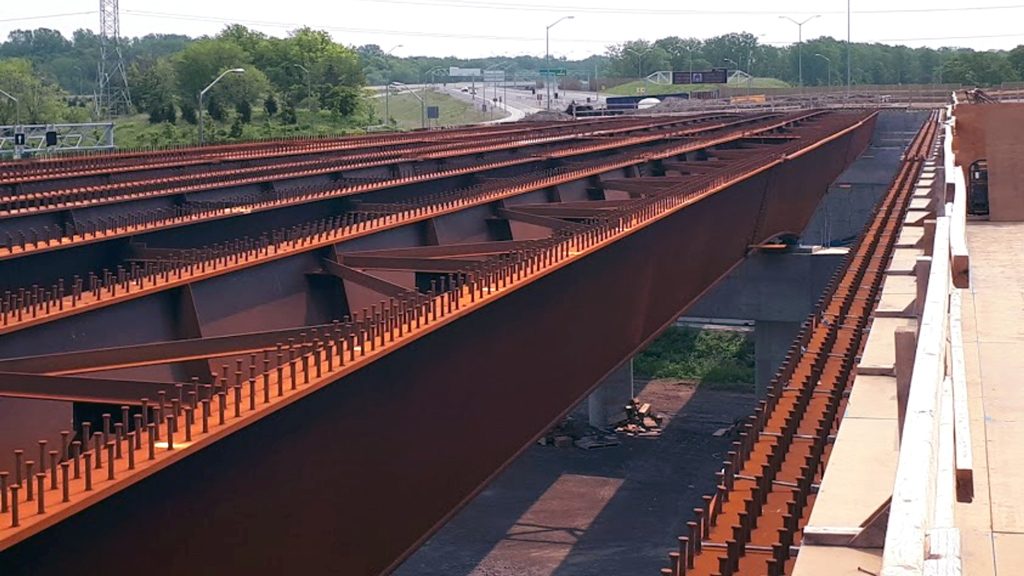To most of the general public, the first visible sign of construction of the new Gordie Howe International Bridge between Windsor and Detroit is a 170-metre long overpass connecting Hwy. 401 to what will be the new bridge’s Canada Customs inspection plaza.
Work began in 2017 and should be completed by the end of this year on the structure over the city’s busy west side Ojibway Parkway, a major commuting route which carries 25,000 vehicles a day.
The $27.5 million overpass, being constructed by Windsor-based Facca Inc., which also crosses a railroad track and the Customs plaza footprint’s already completed Perimeter Access Road (PAR), will include ramps connecting the plaza to and from Ojibway Parkway.
All the while, work has proceeded through construction staging to avoid major commuter traffic disruptions, with eight overnight road closures and several partial daytime interruptions.
While the work is being carried out under the auspices of Ontario’s transportation ministry (MTO), prep work was done under the Windsor-Detroit Bridge Authority (WDBA), the federal agency overseeing the Gordie Howe bridge construction itself. This preliminary work, such as planting wick drains, building a drainage layer and depositing advanced fill, was carried out by Windsor’s Amico Infrastructure as part of the $50 million so-called Gordie Howe bridge early works, which included relocation of utilities and construction of the customs plaza footprint and PAR.
Those wick drains were necessary because of the general west Windsor soil conditions. Adjacent to the Detroit River, the ground is notoriously soggy.

“The soil conditions here are very poor,” MTO project manager Nasser Shahatto said. “We had to go down to bedrock so we could have a solid foundation to carry the bridge.” A total of 4,422 metres length of H piles were driven. As well, almost 35,000 tonnes of the heaviest aggregate, Granular B Type Three, was pre-loaded “to consolidate the soil,” Shahatto said.
During the piling, the major challenge was undertaking work without disturbing a vast array of utilities that have been long underground. These included such sensitive structures as a suburban municipality’s sanitary main, electrical utility ducts and gas lines.
“There’s a lot of utilities and vibration was a major concern,” Shahatto said. “A lot of the utilities here are old, fragile so we had to make sure that we didn’t damage them or have a problem with them.”
Crews measured vibrations during pile driving. “So that delayed us somewhat but that was the right thing to do,” the official said. As it turned out there were no utility disruptions. “We never exceeded the allowable vibration levels,” he said.
With the six-weeks of piling completed, work then began on the foundations, including pouring 580 cubic metres of concrete, then building the columns and pier caps, east and west side abutments, and installing the 48 girders — six girder sections along eight lines.
Each row of girders covers the four-lane Ojibway Parkway, Essex Terminal Railway’s single track and the PAR. The first two spans of girders are 68.5 metres in length each and the third, over the PAR, is 33 metres. The width across the entire six-lane shouldered deck is 43 metres.
The longish spans required steel “because you can span a lot more with steel than with concrete,” Shahatto said. Moreover, the girder depth can be less and that was important because there had to be a seven metre height over the railroad track.
The girders were manufactured by Quebec City’s Canam-Bridges. They were transported by truck to the site and assembled and hoisted over the piers, using a 600 tonne main crane and 100 tonne crane to align them.
The girder erection sequence began with the installation of a balanced cantilever hunched girder section over the east pier. This was followed by a drop-in segment to the east, spanning Ojibway Parkway to the eastern abutment and current Hwy. 401 terminus. Next, a drop-in segment was erected to the west, spanning the ETR tracks to the west pier. The final step was a girder segment spanning the PAR to the western abutment leading to the Customs plaza and eventual Gordie Howe bridge.
Meanwhile, connecting the structure to the Customs plaza footprint, still ongoing, requires a combination of cellular concrete — there are two batching plants on site — poured into already constructed forms on two sides. These will border the expanded polystyrene (EPS) blocks laid in the centre. All this will be lined on the north and south walls by tied back RSS (retained soil system) jigsaw-like wall panels.
Also, falsework and forming is taking shape on the bridge deck, with the eastbound set of lanes virtually completed. Rebar will be placed and the 225 millimetre concrete deck poured, with the lanes completed by the end of June and westbound lanes by September. Finally, there will be waterproofing and two lifts of asphalt before vehicles can use them. The voluminous steel girder Nelson studs attached to the girders will anchor the finished deck.
While it will still be some time before motorists will use the overpass to reach the Gordie Howe bridge — the latest bridge construction completion date is 2024 — the overpass could see some use before that.
Shahatto said MTO is in talks with the bridge authority to use the structure for bridge construction vehicles and materials. “They’ve talked to us about maybe using it as access to their site for larger components of the Gordie Howe bridge,” he said.











Recent Comments